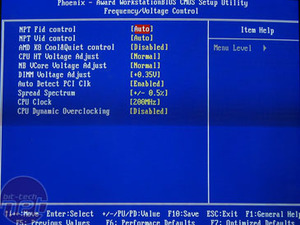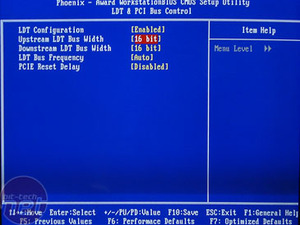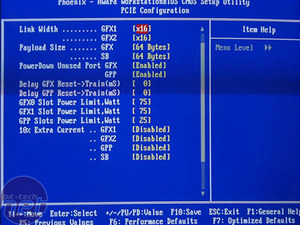The Back I/O panel is a reasonably standard affair with the exception of the ECS Cooling Accelerator. There are two PS/2 ports, a serial port, optical and coaxial S/PDIF out, a 10/100/1000 Gigabit Ethernet port, a 10/100 Ethernet port, four USB 2.0 ports and six 3.5mm audio jacks for the on-board Realtek 8-channel ALC883 HD audio codec.




 The main overclocking options are located under the Frequency/Voltage Control menu; the highlights include:
The main overclocking options are located under the Frequency/Voltage Control menu; the highlights include:
Other configuration options of interest include PCI-Express x16 slot power adjustments from 75-250W along with the option to increase the current supplied to the two PCI-Express x16 slots, the northbridge and southbridge by 10%. We think that the option to increase the power draw through the PCI-Express slots is a rather strange inclusion - the electrical noise and heat created through the traces will work against the boards' stability, as it is likely to affect other components on the board too.

BIOS
The BIOS is a standard Phoenix Award BIOS with all of the necessary options for the on-board components. We used the latest BIOS from the ECS home page at the time we tested - version V1.0J, dated 07/07/2006.



- NPT Fid control (CPU multiplier) adjustable from 4.0x to CPU Max.;
- NPT Vid control (CPU Voltage) adjustable from 0.550V to 0.800V in 0.0125V steps and then from 0.800V to 1.400V in 0.0250V increments;
- CPU HT Voltage Adjust (HyperTransport Voltage): Normal, +0.05V, +0.10V, +0.15V;
- NB VCore Voltage Adjust (Northbridge Voltage): Normal, +0.05V, +0.10V, +0.15V;
- DIMM Voltage Adjust (Memory Voltage): Normal, +0.05V to +0.35V in 0.05V increments;
- CPU Clock adjustable from 200-500MHz in 1MHz increments;
- CPU Dynamic Overclocking adjusts the CPU Clock dynamically from 'disabled' to 30MHz in 2MHz increments.
Other configuration options of interest include PCI-Express x16 slot power adjustments from 75-250W along with the option to increase the current supplied to the two PCI-Express x16 slots, the northbridge and southbridge by 10%. We think that the option to increase the power draw through the PCI-Express slots is a rather strange inclusion - the electrical noise and heat created through the traces will work against the boards' stability, as it is likely to affect other components on the board too.

MSI MPG Velox 100R Chassis Review
October 14 2021 | 15:04






Want to comment? Please log in.